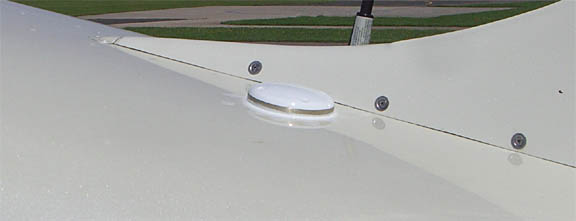
Airborne Satellite Weather Data - Part 2
Overview
This is the second part of the airborne satellite weather data project and was originally written in 2010. The first part covered the basic groundwork of testing different phones and finding the best way to proceed. It also established that a standard panel mounted MFD (multifunction display) is capable of displaying textual information such as METARs and TAFs (airport actual and forecast weather, respectively).
Rooftop Antenna
The first rooftop antenna tested was 3G1216RL-P-XSS-1 from Antcom. This is a TSO approved product and was installed under a field approval (US registered aircraft) with a 337, done by an FAA 145 Repair Station. This antenna also supports L2 GPS which is not applicable to aviation as yet.
This antenna was not successful. Initially a lot of time was wasted because the two antenna connectors (Thuraya and GPS) were reversed relative to the antenna drawing, and the Thuraya signal coming out of the GPS connector was unsuprisingly poor. Before this error was discovered, a great deal of time was spent trying to reduce attenuation in the system, by gradually improving the grade of coax cable used. The antenna-bulkhead cable (approx 1.5m in length) was even replaced with RG402 mil-spec semi-rigid coax which has the lowest attentuation of any commonly available microwave cable.
By the time the connector swap error was discovered, Antcom offered a different (also TSO approved) antenna whose data showed a slightly higher gain but they claimed it really was a lot better especially in the corners of the Thuraya spectrum, so this antenna was installed. The P/N and description is
3GNSS1516RL-P-XSS-1
Passive LHCP Rx/Tx Thuraya and Passive RHCP L1 GPS Antenna with 2 SMA connectors,
white.
and it is on page 7 of the full Antcom catalogue. The GPS portion of this antenna supports only L1 GPS, which is fine for aviation.

As per standard practice, there is a reinforcing plate underneath the antenna, inside the hull, which is riveted in (with flush rivets, to make a neater job) around its edges.
Note that the large airframe fillet behind the antenna is made from thin plastic, not metal, and does not affect reception on that azimuth. The all-metal vertical stabiliser is a bit further along to the right however and not a lot can be done about that...
The new antenna worked OK. The vertical stabiliser was expected to introduce a blind spot and flight tests confirmed this - flying on a heading of around 330 is not advisable if you want satellite reception at the same time... The only solution would be to mount the satellite antenna on the forward roof surface - this would involve the relocation of every other antenna on the aircraft and was not worth doing.
The two antenna connectors were brought out to two RF connectors in the rear bulkhead of the luggage compartment and this was the full extent of the certified installation
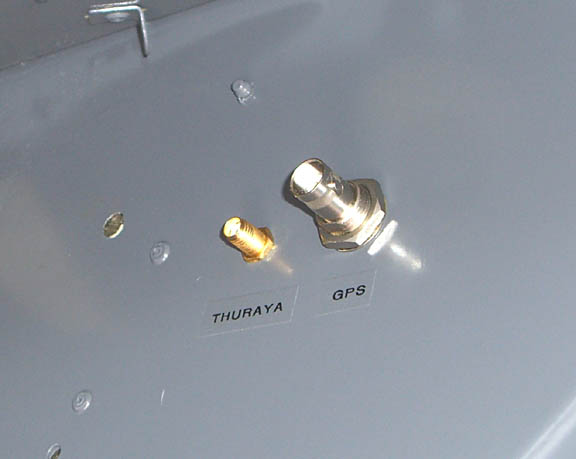
The GPS connection was made with RG400 (the best quality aviation-spec commonly available coax) and the Thuraya connection, originally RG400 also, was eventually made with RG402 semi-rigid coax

as described earlier. RG402 offers the lowest possible attenuation (short of going to exotic microwave cables, with impractical minimum bend radii - brochure - picture) and its solid copper jacket ensures virtually zero radiation within the aircraft. Due to the power involved, and the Thuraya frequency being quite close to GPS, it is very important that all this is done to the highest standard. The two different connector types were used to prevent an accidental swap. The GPS portion of the antenna could be used for other purposes but it is a passive antenna only and would not work with most common aviation GPS receivers.
The Hughes 7100 phone was mounted in the Sattrans SAT-DOCKER car holder, next to the rear left seat
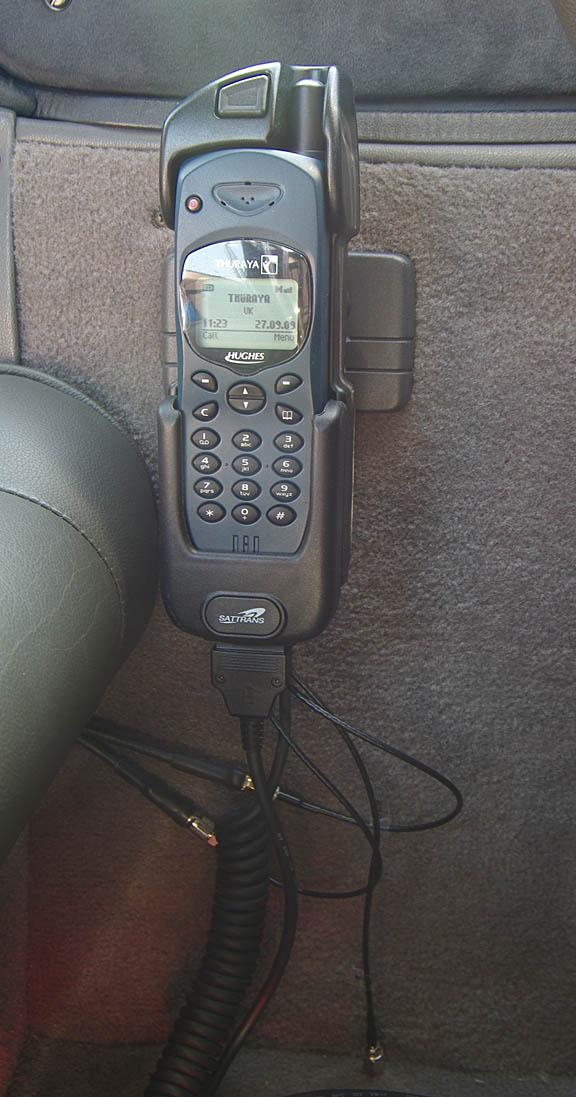
The above pic shows the three RF cables coming out of the car holder. Two of them (Thuraya and GPS) are connected to the aforementioned two RF connectors (using RG400 cable) and the third (GSM) is unused. It also shows the USB-7100 data cable which instead of plugging into the bottom of the phone now plugs into the bottom end of the car holder.
Of the two RF connectors connecting to the car holder RF leads, one is SMA and the other is an unusual type used in the vehicle phone business: RS 448-1605 FME PLUG RG58.
The remaining cable is the coiled power supply to the car holder; this charges the phone and powers the GPS repeater inside the car holder (see below). The supply is 12V/14V so 24V/28V aircraft will need a converter. I already have a custom built compact multi-output power unit with numerous outputs, for the LS800 tablet computer and other items, and a 12V output was added to this.
The car holder was conveniently (and removably) attached to the removable portion of an ashtray
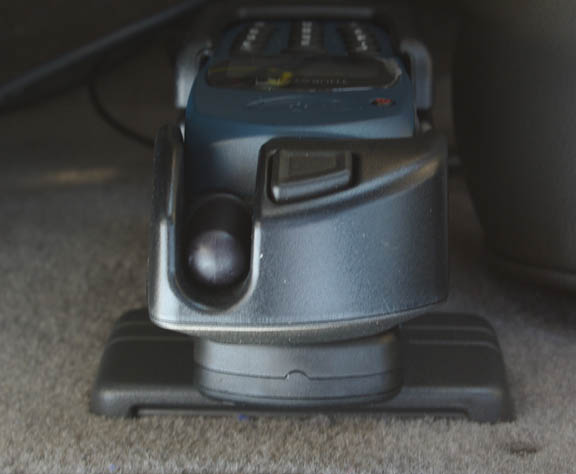
In this location, the phone is not easily pilot-accessible but can be reached if necessary.
During initial testing, I found it impossible to get a GPS fix with the phone in the car holder. Dismantling the car holder yielded the answer: the two RF connectors in the back of the phone are Thuraya and GSM; there is no GPS connector... The signal from an external antenna to the phone's GPS receiver is instead transferred using a small powered repeater inside the car holder, shown below on the little PCB, which re-radiates the GPS signal the very short distance to the phone
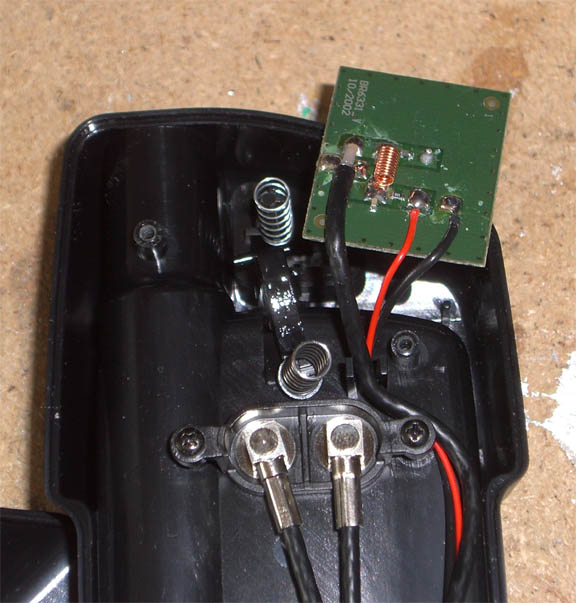
and obviously this item needs the car holder to be powered, and I was doing the tests without power!
The 7100 phone manual does not say what attenuation the various signal strength bars correspond do. However, a quick test done by inserting calibrated 3db SMA attenuators into the cable suggests that each dot corresponds to about 1.5 to 2.0db.
The above Sattrans car holder was found to have a major issue: it contains a switching power supply (input range approx 11V-16V) which provides a presumably regulated 10V supply to the phone, and this is a crude design with close to zero filtering and it radiates RF muck all over the place. In the TB20GT it does not affect navigation instruments but does interfere substantially with VHF communications, with noise on many frequencies pushing the radios out of the auto-squelch range which is extremely irritating because, all the time there is no talking on the channel, there is a loud "static" noise. In fact I would be suprised if this product was usable in any motor vehicle which has a normal terrestrial-station VHF radio installed.
Unfortunately, one obvious solution - replacing the switching power supply with a linear regulator - would be messy because of the way is shares a PCB with some (in this application, unused) headset electronics, and with everything connected up with flat IDC cables... Fortunately, most of the interference is conducted, not radiated, and I eventually solved it by leaving the switching power supply in place and installing a very good 2-stage LC filter into the power lead, close to where it enters the car holder base. The rest of the power cable was re-done with a shielded cable whose ground goes to the aircraft ground and nowhere else.
More unfortunately, there is an unavoidable continuous connection between
- the ground of the car holder power supply (which is generating the RF muck)
- the ground of the RS232 data connection of the phone / car holder
- the ground of the "computer" (whatever form the computer takes)
- the ground of the computer's VGA output
- the ground of the NTSC video output
- the ground of the MFD video input
which makes it tricky to block the conducted RFI generated by the car holder... a bluetooth connection between the phone and the "computer" would seem a great way to deal with this.
Of course one can put a ferrite filter into the RS232 cable, too, but these filters tend to not do very much.
It was later discovered that Thuraya list a self contained module (local copy) which might be preferable for some installations

Thuraya never revealed the existence of this product despite being asked many times if they do such a thing. However, their customer service is poor. One drawback of this product however is that it does not have a signal strength display or any other means of showing whether anything is working.
Update July /2014
This car-holder project was eventually abandoned, for two reasons: the interference from the Sattrans car holder power circuitry was impossible to get rid of adequately, and the 7100 phone doesn't always hang up reliably so at the $1/minute dial-up rate you could blow a $200 prepayment on just one flight. Mounting the car holder in an easily pilot visible location would solve the second problem but there is no such location in the TB20 cockpit.
I continued to use the 7100 phone via an USB-RS232 connection with a windows 8 tablet (Lenovo Tablet 2) and in that mode it always did hang up reliably. However the Thuraya system is not 100% reliable and sometimes (rarely, but ...) the phone simply does not make a connection and needs to be power cycled, which again does not really support the use of a car holder whose very purpose is to create an easy to use installation which doesn't need fiddling around.
So I moved to the Thuraya XT phone, again with the windows 8 tablet, over a USB connection. This produced the most reliable solution, and the cheapest to use because of the "GMPRS" service is metered per MB and not per minute. There are still reliability issues due to Thuraya's flakey systems but it usually works OK after the first 10-20 minutes following the initial connection.
Update July 2018
The Thuraya XT turned out to be around 90% reliable for getting an internet connection and eventually I went to the Golze ADL150 Iridium based system. This costs 30-40 euros per month which appears to be a lot more than the Thuraya option but in reality the mysterious Thuraya "prepayment balance stealing" billing policies, together with their atrocious customer service, were not any cheaper over the years. It uses a dedicated app (available for IOS and Android only) and due to the very slow data channel on Iridium there is no internet access via this system. It appears to work solidly, which is important, and you get radar and sferics data (georeferenced around the aircraft position and the flight plan programmed into the GPS) plus tafs/metars.
This page last edited 31st July 2018
Any feedback or reports of dead links, corrections or suggestions much
appreciated:
Contact details